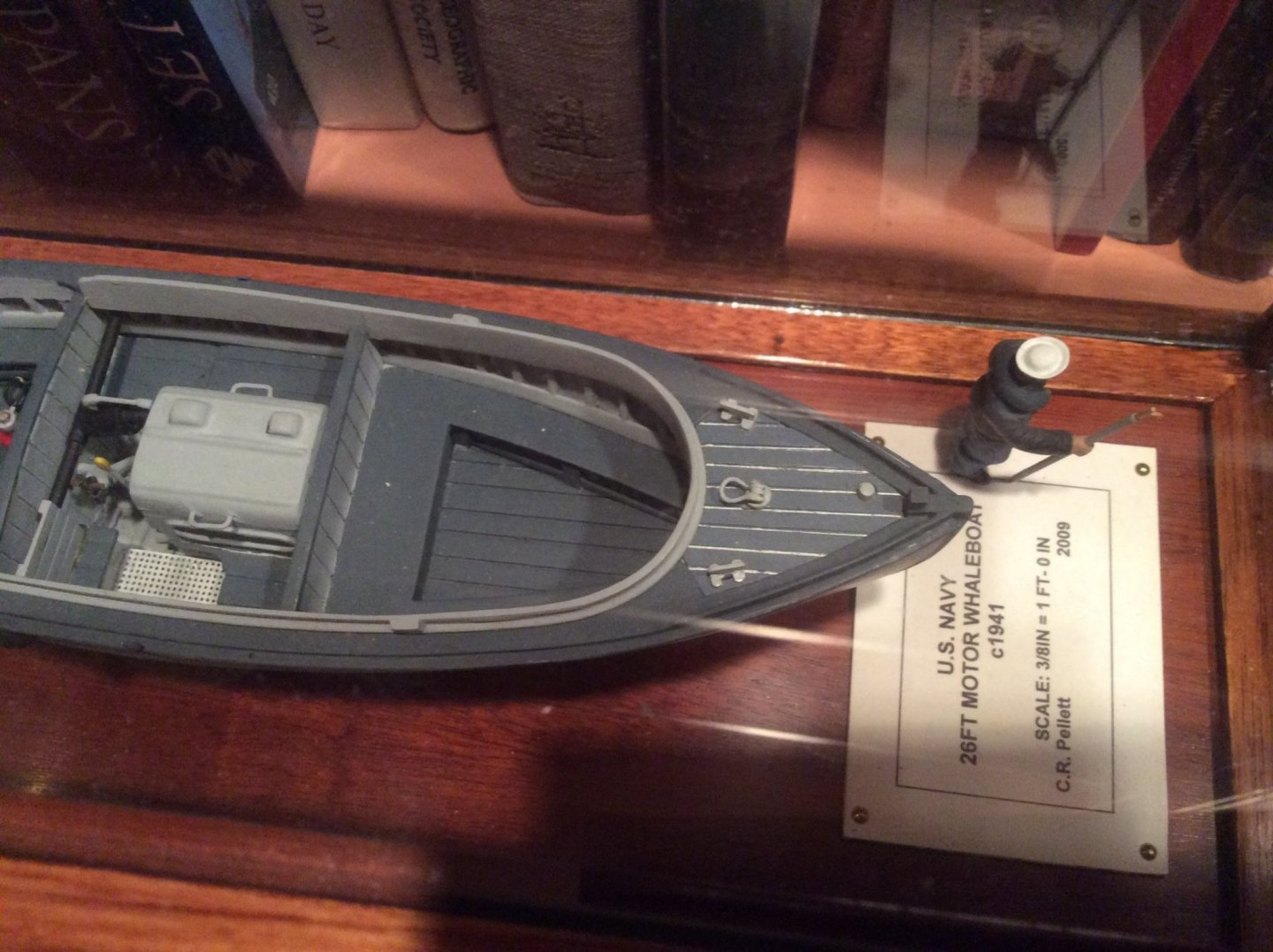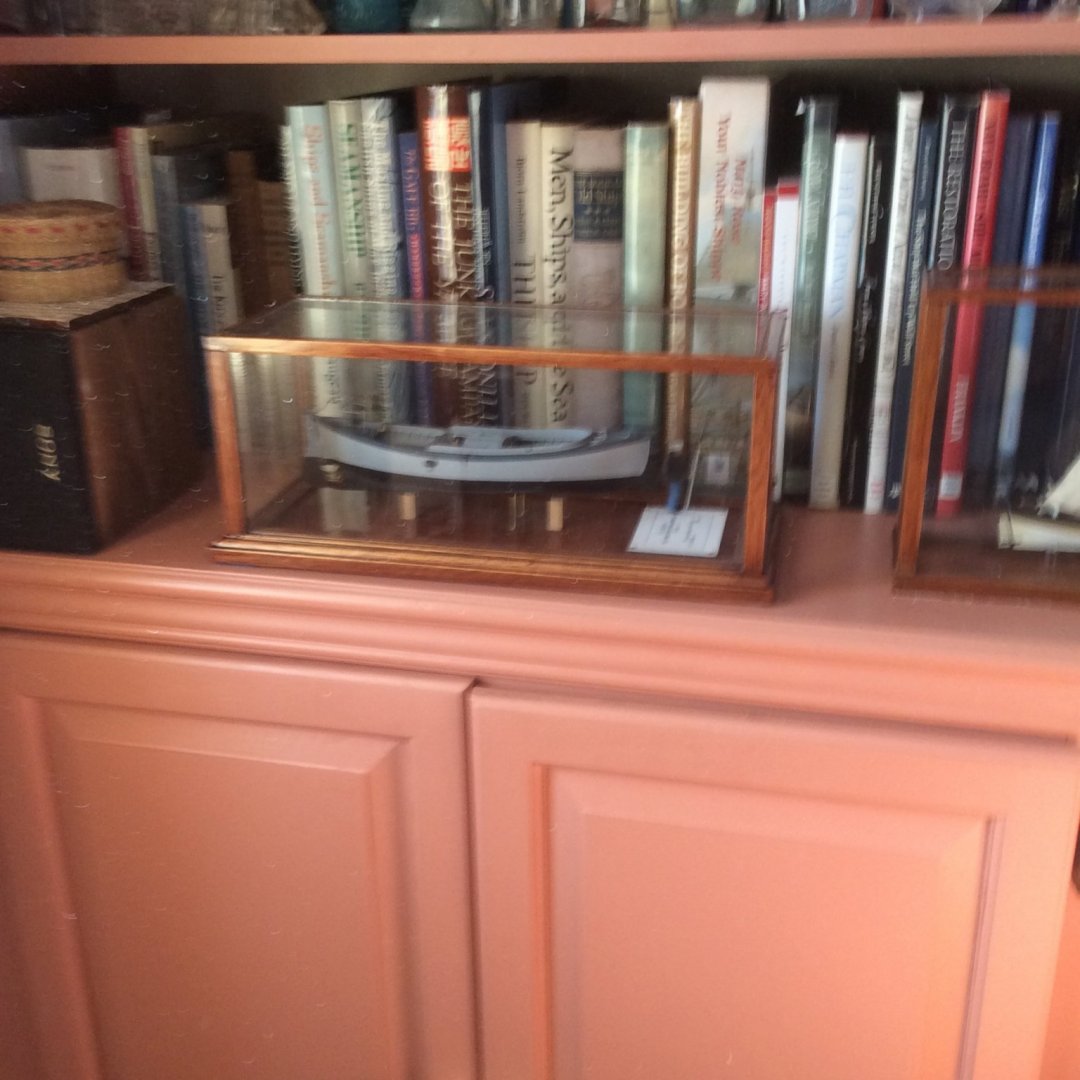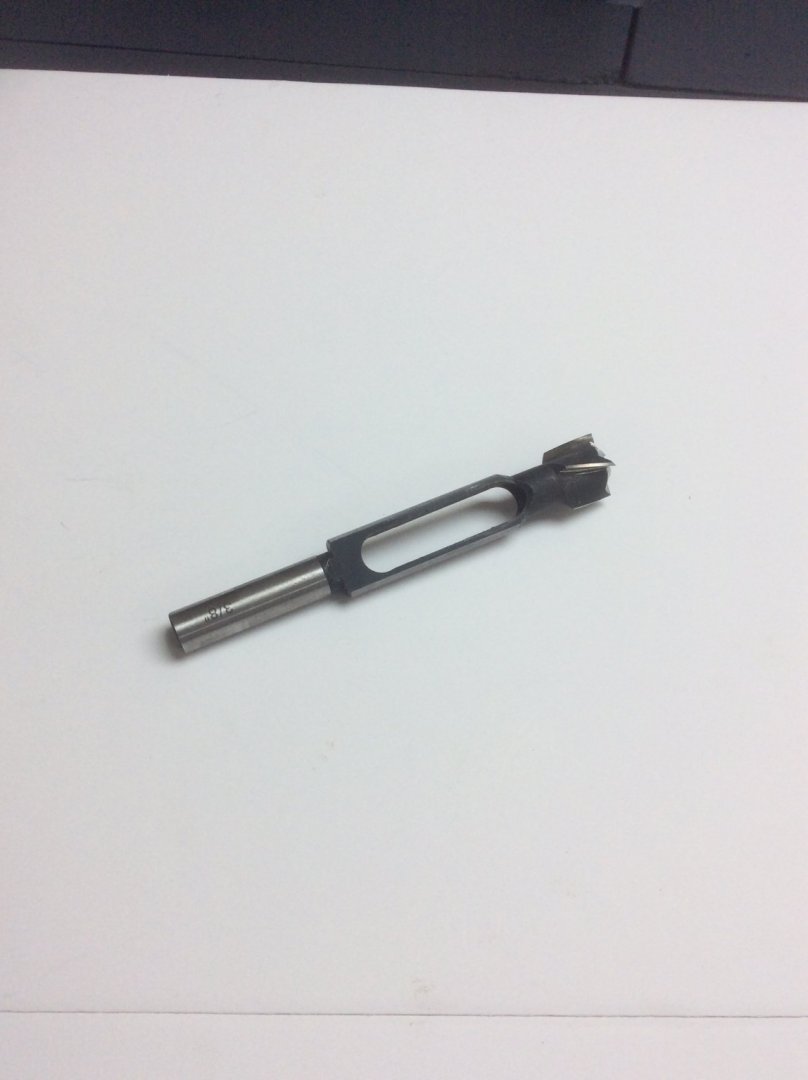
Roger Pellett
NRG Member-
Posts
4,519 -
Joined
-
Last visited
Content Type
Profiles
Forums
Gallery
Events
Everything posted by Roger Pellett
-
This appears to be someone’s interpretation of a wood canvas canoe. I personally think that it is well done. The rocker may be excessive but canoes intended for use in white water river canoeing are built with considerable rocker to improve maneuverability. Likewise River canoes often do not have keels. Unlike other boats a wood canvas canoe does not require a keel as a structural member. A lack of tumblehome would also improve stability in challenging conditions. The real thing would be built from cedar, the ribs 5/32in thick x 2-1/2 in to 3in wide. Planking would be 5/32in to 3/16in white or red cedar. Each canoe builder had his own planking pattern and the planking is not intended to be watertight. Planking is nailed through the ribs with the nail points headed over. No glue is used. The canoe is then covered with heavy canvas. Canvasing is an interesting job. The Canves is made up as an envelope suspended by ropes. The canoe is put in the envelope and stretched longitudinally. I used a boat trailer winch. The canvas is drawn up over the gunnel with plier like tools and nailed or stapled. The nails or staples are later covered up by the outwale. The canvas is not glued to the planking. If the planets are properly aligned the result is a nice smooth canvas cover. The canvas is then treated with a home made coating to waterproof it. I used linseed oil, old oil based paint, powdered silica, and Japan drier all mixed together. The canoe is then painted. The point to all of this is that planking over this otherwise nice model will ruin it. A good paint job- satin or eggshell finish will be as close as you can come to the painted canvas. The Peterborough canoe is a completely different animal with totally different framing, and modifying your canoe will just make it a bastard. From your “handle” it seem that you are interested in Northwoods lore and culture. You can then take satisfaction in knowing that the wood canvas canoe is/was a direct descendant of the Native American’s and Vouyager’s birch bark craft. You should be able to find a huge amount of information about these canoes. Thy looking up the following: Wooden Canoe Heritage Association Wisconsin Canoe Museum, Spooner, Wisconsin Old Town Wood Canvas Canoes Northwoods Canoe Company Roger
- 69 replies
-
- canoe
- restoration
-
(and 1 more)
Tagged with:
-
Allan, Here’s a closeup photo of the caulking. A larger diameter thread gave a crisper caulking line but to me looked fake to I opted for the smaller diameter giving a thinner caulk line. Bruce, A well known naval officer, I don’t remember who, once remarked that “A warship is known by the condition of her boats.” Navies, particularly in peace time made an effort to keep their boats looking smart. This was especially true of boats that transported officers. The US Navy used wooden 26ft Motor Whaleboats from the end of World War I until the early 1960’s when they switched to a fiberglass one of different design. I have found two variations of the same 26ft wooden hull- a completely open utility model and the partially decked one that I modeled that could be used as a captain’s gig. US Navy World War II Destroyers were equipped with one of each. White caulking of the fore deck would have added to the appearance of the boat. A number of Movies about World War II, for example The Enemy Below and The Caine Mutiny show these boats with mahogany trim finished bright. I have chosen to show the boat as it would have appeared during one of the hard fought campaigns early in the war when no one had the time to maintain varnished trim. Roger
-
The model in the picture below is an example where thread was used in depicting a caulked deck but in a different way. The fore deck on this US Navy Motor whaleboat is stained navy “deck blue” with the seams payed with white lead. I made the deck from a piece of 1/16in thick plywood with groves to represent deck seams cut on a miniature table saw. I then sprayed the entire deck with flat white paint and then sanded the paint off the flat surface but leaving it in the grooves. I then pushed a piece of thread into each of the grooves and sprayed the deck piece with the blue deck stain. Removing the thread left the white paint “caulking” in the simulated seams of the blue deck. Roger
-
Eric, The Ohio River Museum in Marietta, Ohio has one of these on display. There are pictures posted on the web. Look up Ohio River yawl boat. Roger
- 599 replies
-
- sidewheeler
- arabia
-
(and 4 more)
Tagged with:
-
Is there a trick to making deadeyes?
Roger Pellett replied to Schooners's topic in Masting, rigging and sails
Here is my trick for making deadeyes with the grain oriented correctly. Use a plug cutter. These are used in boarbuilding to cut plugs to fill counterbored screw holes. Most of these produce short plugs- 1/2in long or so, but some will produce much longer plugs-1-1/2in and they are not too expensive, maybe $15. Unfortunately, the smallest long one that I was able to find cuts a 3/8in dia plug but at least I now had a round piece with the grain oriented correctly (crosswise) that I could easily chuck up in my lathe and turn to the correct diameter. You will need a drill press to turn the plug cutter. -
That’s right. The Mid Nineteenth Century Clippers were often referred to as “sharp” as well as the earlier Baltimore Clippers even though they had completely different hull forms. Roger
-
I have been rereading a book about the air war in Korea. In that case, attack aircraft - Corsairs and AD’s were propeller driven and the fighters were jets-F9F Panthers. The launch sequence was attack aircraft first, and the shorter legged jet fighters much later with the rendezvous taking place closer to the target. In this case the short legged MIGs did not pose a threat until the strike group neared the target and only then if the target was near “MIG Alley.” The book’s author also claims that the difficulties maintaining the heavy attack schedule accelerated the adoption of the angled deck. Roger
-
An older and More specialized book that you might wish to refer to is Chapelle’s Baltimore Clipper.
-
Back in the 1950’s A.J. Fisher listed plans of Wanderer in their catalog. They are still in business owned by Model Expo?, anyhow if you google A.J. Fisher you should find them. Maybe they can produce a set for you. You might also wish to get a copy of the book “Whaleships and Whaling” by Church. Great photos taken on board sailing whalers towards the end of the period. Should be easy to find on used book sites. Roger
-
In The recently published biography of Norman Ough, the author writes of Ough’s frustration of the wholesale destruction in the 1950s by the British Admiralty of a huge amount of pre WWII Royal Navy design documents. The Company that I used to work for (Dravo Corporation) operated a large shipyard on the Ohio River near Pittsburgh, Pa where they built barges and river towboats. They were also the “lead yard” for the WWII LST construction program. They operated another yard during WWII at Wilmington, DE where they built Destroyer Escorts and PC patrol craft. All of the design drawings were stored in an inactive salt mine. Both yards have long since closed and the Company no longer exists. Somewhere there is a treasure trove of drawings, but completely inaccessible. Roger
-
I am resuming work on a project that requires a lot of soldering of brass. I will post a build log soon. Before suspending work several years ago I had a small Bernz-o-magic Propane hose torch that had a shut-off valve at the bottle and an adjustment valve at the torch head. Unfortunately I no longer have it and it would seem to be no longer made. I am willing to spend the money to buy a quality replacement and have been looking at the Smith Little Torch. My concern is that they all seem to be combination Propane and Oxygen and I don’t want to deal with Oxygen and don’t need the extra heat. Does Smith make a Propane only model? Can the Propane Oxygen Model be used on straight Propane by shutting off the Oxygen valve? Can anyone suggest a quality Propane only mini hose torch with flame adjustment at the torch head? Roger
-
Very nice job! If it is your intent to finish this as a model, there are two good books on this subject by Tom Cunliff: Hand, Reef, and Steer and Pilot Cutter’s Under Sail. Roger
- 15 replies
-
- jolie brise
- pilot
-
(and 1 more)
Tagged with:
-
A number of years ago there was a 3 or 4 part series in the Nautical Research Journal about a model of Kearsarge. It includes considerable research material. Call the Guild office about ordering reprints. Roger
-
Bell UH-1H Huey By lmagna - Dragon - 1/35 - PLASTIC
Roger Pellett replied to lmagna's topic in Non-ship/categorised builds
Wow, they didn’t pay for mine. Of course different state’s insurance rules can vary. Maybe Oregon’s offer different coverage than Minnesota. My wife also refuses to understand that I can’t hear her with her back to me and her head in the refrigerator. -
Bell UH-1H Huey By lmagna - Dragon - 1/35 - PLASTIC
Roger Pellett replied to lmagna's topic in Non-ship/categorised builds
Yeah, me too. My hearing was tested several years ago and hearing aids were prescribed. Expensive! In these “industrial space” restaurants they seem to pick up ambient noise much better than conversation at the table annoying my wife who thinks that since I am wearing my “ears” I should be hearing everything that she has to say in her ladylike modulated voice. Ken, it is my understanding that the VA will provide hearing aids for service connected hearing loss. Roger -
Basic but Good kit recommendations for granddaughter and I
Roger Pellett replied to glbarlow's topic in Wood ship model kits
Check the WoodenBoat Store (WoodenBoat.com). They have advertised boat models especially for young model builders. Roger -
Eric, This month’s WoodenBoat Magazine has a nice article about Arabia, her salvage and the museum. Like most magazine articles it is short on detailed information, most if not all you probably know but nice recognition nonetheless. I’ll send you my copy when I’m done with it if you like. Roger
- 599 replies
-
- sidewheeler
- arabia
-
(and 4 more)
Tagged with:
About us
Modelshipworld - Advancing Ship Modeling through Research
SSL Secured
Your security is important for us so this Website is SSL-Secured
NRG Mailing Address
Nautical Research Guild
237 South Lincoln Street
Westmont IL, 60559-1917
Model Ship World ® and the MSW logo are Registered Trademarks, and belong to the Nautical Research Guild (United States Patent and Trademark Office: No. 6,929,264 & No. 6,929,274, registered Dec. 20, 2022)
Helpful Links
About the NRG
If you enjoy building ship models that are historically accurate as well as beautiful, then The Nautical Research Guild (NRG) is just right for you.
The Guild is a non-profit educational organization whose mission is to “Advance Ship Modeling Through Research”. We provide support to our members in their efforts to raise the quality of their model ships.
The Nautical Research Guild has published our world-renowned quarterly magazine, The Nautical Research Journal, since 1955. The pages of the Journal are full of articles by accomplished ship modelers who show you how they create those exquisite details on their models, and by maritime historians who show you the correct details to build. The Journal is available in both print and digital editions. Go to the NRG web site (www.thenrg.org) to download a complimentary digital copy of the Journal. The NRG also publishes plan sets, books and compilations of back issues of the Journal and the former Ships in Scale and Model Ship Builder magazines.




